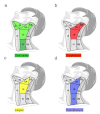Current advances in diagnosis and surgical treatment of lymph node metastasis in head and neck cancer
- PMID: 23320056
- PMCID: PMC3544246
- DOI: 10.3205/cto000086
Current advances in diagnosis and surgical treatment of lymph node metastasis in head and neck cancer
Abstract
Still today, the status of the cervical lymph nodes is the most important prognostic factor for head and neck cancer. So the individual treatment concept of the lymphatic drainage depends on the treatment of the primary tumor as well as on the presence or absence of suspect lymph nodes in the imaging diagnosis. Neck dissection may have either a therapeutic objective or a diagnostic one. The selective neck dissection is currently the method of choice for the treatment of patients with advanced head and neck cancers and clinical N0 neck. For oncologic reasons, this procedure is generally recommended with acceptable functional and aesthetic results, especially under the aspect of the mentioned staging procedure. In this review article, current aspects on pre- and posttherapeutic staging of the cervical lymph nodes are described and the indication and the necessary extent of neck dissection for head and neck cancer is discussed. Additionally the critical question is discussed if the lymph node metastasis bears an intrinsic risk of metastatic development and thus its removal in a most possible early stage plays an important role.
Keywords: head and neck cancer; lymph node metastasis; lymphogenic metastasis; neck dissection.
Figures







References
-
- Werner JA. Aktueller Stand der Versorgung des Lymphabflusses maligner Kopf-Halstumoren. Eur Arch Otorhinolaryngol. 1997;Suppl I:47–85. - PubMed
-
- Gold KA, Lee HY, Kim ES. Targeted therapies in squamous cell carcinoma of the head and neck. Cancer. 2009 Mar;115(5):922–935. doi: 10.1002/cncr.24123. Available from: http://dx.doi.org/10.1002/cncr.24123. - DOI - DOI - PubMed
-
- Richard JM, Sancho-Garnier H, Micheau C, Saravane D, Cachin Y. Prognostic factors in cervical lymph node metastasis in upper respiratory and digestive tract carcinomas: study of 1,713 cases during a 15-year period. Laryngoscope. 1987 Jan;97(1):97–101. doi: 10.1288/00005537-198701000-00019. Available from: http://dx.doi.org/10.1288/00005537-198701000-00019. - DOI - DOI - PubMed
-
- Jones AS, Roland NJ, Field JK, Phillips DE. The level of cervical lymph node metastases: their prognostic relevance and relationship with head and neck squamous carcinoma primary sites. Clin Otolaryngol Allied Sci. 1994 Feb;19(1):63–69. doi: 10.1111/j.1365-2273.1994.tb01150.x. Available from: http://dx.doi.org/10.1111/j.1365-2273.1994.tb01150.x. - DOI - DOI - PubMed
-
- Puri SK, Fan CY, Hanna E. Significance of extracapsular lymph node metastases in patients with head and neck squamous cell carcinoma. Curr Opin Otolaryngol Head Neck Surg. 2003 Apr;11(2):119–123. doi: 10.1097/00020840-200304000-00010. Available from: http://dx.doi.org/10.1097/00020840-200304000-00010. - DOI - DOI - PubMed
LinkOut - more resources
Full Text Sources

